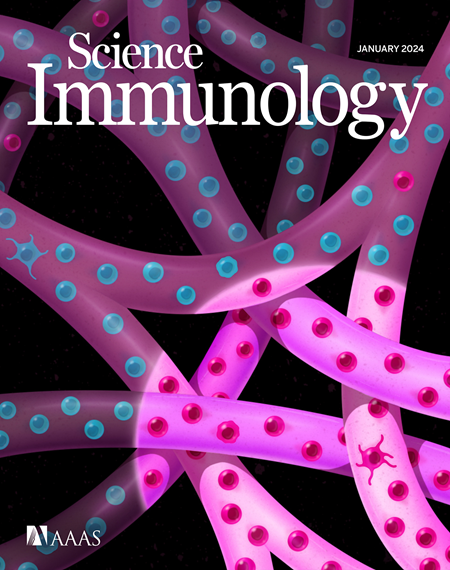人类巨细胞病毒 UL18 可阻止 MHC-E 和 MHC-II 限制性 CD8+ T 细胞的启动。
IF 16.3
1区 医学
Q1 IMMUNOLOGY
引用次数: 0
摘要
恒河猴巨细胞病毒(RhCMV)载体可诱导主要组织相容性复合体(MHC)-E 限制性 CD8+ T 细胞,从而严格控制恒河猴体内的猿免疫缺陷病毒(SIV)。这些反应需要删除 8 个 RhCMV 趋化因子样开放阅读框(ORF),而这些开放阅读框在人类巨细胞病毒(HCMV)中是保守的。为了确定 HCMV 是否编码了额外的、非保守的非常规 T 细胞引物抑制因子,我们在趋化因子缺陷株(68-1 RhCMV)中插入了 41 个 HCMV 特异性 ORF。对表位识别的监测显示,HCMV UL18 能阻止非常规 T 细胞的启动,从而产生 MHC-Ia 靶向反应。UL18 与 MHC-I 同源,但不与 T 细胞受体结合,而是与抑制性白细胞免疫球蛋白样受体-1(LIR-1)高亲和力结合。缺乏 LIR-1 结合的 UL18 不再干扰 RhCMV 感染细胞对 MHC-E 限制性 T 细胞的刺激,也不再干扰非传统限制性 T 细胞的诱导。因此,需要从 HCMV/HIV 疫苗的 UL18 中删除 LIR-1 结合,以诱导保护性 MHC-E 限制性 T 细胞。本文章由计算机程序翻译,如有差异,请以英文原文为准。
Human cytomegalovirus UL18 prevents priming of MHC-E– and MHC-II–restricted CD8+ T cells
Rhesus cytomegalovirus (RhCMV) vectors elicit major histocompatibility complex (MHC)–E–restricted CD8+ T cells that stringently control simian immunodeficiency virus (SIV) in rhesus macaques. These responses require deletion of eight RhCMV chemokine-like open reading frames (ORFs) that are conserved in human cytomegalovirus (HCMV). To determine whether HCMV encodes additional, nonconserved inhibitors of unconventional T cell priming, we inserted 41 HCMV-specific ORFs into a chemokine-deficient strain (68-1 RhCMV). Monitoring of epitope recognition revealed that HCMV UL18 prevented unconventional T cell priming, resulting in MHC-Ia–targeted responses. UL18 is homologous to MHC-I but does not engage T cell receptors and, instead, binds with high affinity to inhibitory leukocyte immunoglobulin-like receptor–1 (LIR-1). UL18 lacking LIR-1 binding no longer interfered with MHC-E–restricted T cell stimulation by RhCMV-infected cells or the induction of unconventionally restricted T cells. Thus, LIR-1 binding needs to be deleted from UL18 of HCMV/HIV vaccines to allow for the induction of protective MHC-E–restricted T cells.
求助全文
通过发布文献求助,成功后即可免费获取论文全文。
去求助
来源期刊

Science Immunology
Immunology and Microbiology-Immunology
CiteScore
32.90
自引率
2.00%
发文量
183
期刊介绍:
Science Immunology is a peer-reviewed journal that publishes original research articles in the field of immunology. The journal encourages the submission of research findings from all areas of immunology, including studies on innate and adaptive immunity, immune cell development and differentiation, immunogenomics, systems immunology, structural immunology, antigen presentation, immunometabolism, and mucosal immunology. Additionally, the journal covers research on immune contributions to health and disease, such as host defense, inflammation, cancer immunology, autoimmunity, allergy, transplantation, and immunodeficiency. Science Immunology maintains the same high-quality standard as other journals in the Science family and aims to facilitate understanding of the immune system by showcasing innovative advances in immunology research from all organisms and model systems, including humans.
 求助内容:
求助内容: 应助结果提醒方式:
应助结果提醒方式:


